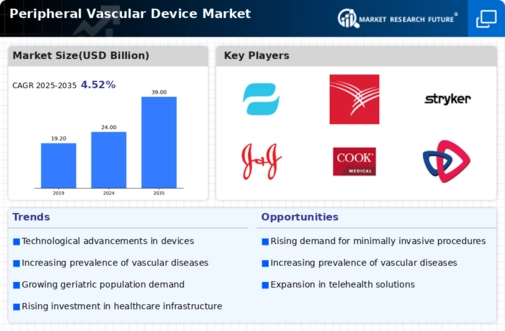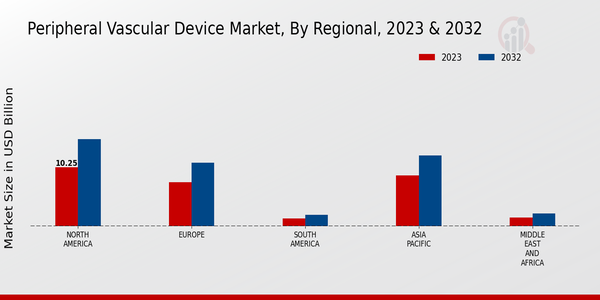Market Growth Projections
The Global Peripheral Vascular Device Market Industry is poised for substantial growth, with projections indicating a market value of 24.0 USD Billion in 2024 and an anticipated increase to 39.0 USD Billion by 2035. This growth trajectory reflects a compound annual growth rate (CAGR) of 4.52% from 2025 to 2035. The market's expansion is driven by various factors, including technological advancements, increasing prevalence of vascular diseases, and an aging population. These dynamics suggest a robust future for the industry, with opportunities for innovation and investment.
Rising Geriatric Population
The global increase in the geriatric population is a significant factor influencing the Global Peripheral Vascular Device Market Industry. As individuals age, they are more susceptible to vascular diseases, necessitating the use of peripheral vascular devices for effective management. According to demographic studies, the proportion of individuals aged 65 and older is expected to rise substantially in the coming years, leading to a higher demand for medical interventions. This demographic shift is likely to drive the market's growth, with estimates suggesting that the market could reach 39.0 USD Billion by 2035, reflecting the urgent need for innovative vascular solutions.
Growing Awareness and Education
Increased awareness and education regarding vascular health are contributing to the expansion of the Global Peripheral Vascular Device Market Industry. Public health campaigns and educational initiatives are informing patients and healthcare providers about the risks associated with vascular diseases and the available treatment options. This heightened awareness is leading to earlier diagnosis and intervention, which is crucial for effective management. As patients become more informed, they are more likely to seek medical advice and treatment, thereby driving demand for peripheral vascular devices. This trend is expected to support the market's growth trajectory in the coming years.
Regulatory Support and Approvals
Regulatory bodies are playing a pivotal role in shaping the Global Peripheral Vascular Device Market Industry through streamlined approval processes and supportive policies. Initiatives aimed at expediting the approval of innovative devices are encouraging manufacturers to invest in research and development. For instance, the U.S. Food and Drug Administration has implemented programs to facilitate faster access to new technologies, which can significantly impact market dynamics. This regulatory support not only fosters innovation but also enhances patient access to advanced treatment options, thereby promoting market growth.
Increasing Prevalence of Vascular Diseases
The rising incidence of vascular diseases globally is a primary driver of the Global Peripheral Vascular Device Market Industry. Conditions such as peripheral artery disease and varicose veins are becoming more prevalent due to factors like aging populations and lifestyle changes. For instance, the World Health Organization indicates that cardiovascular diseases are the leading cause of death worldwide, prompting a growing demand for effective treatment options. This trend is expected to contribute significantly to the market's growth, with projections estimating the market value to reach 24.0 USD Billion in 2024.
Technological Advancements in Device Design
Innovations in the design and functionality of peripheral vascular devices are propelling the Global Peripheral Vascular Device Market Industry forward. Advances such as minimally invasive techniques, improved biocompatibility, and enhanced imaging capabilities are transforming treatment approaches. For example, the introduction of drug-eluting stents and bioresorbable vascular scaffolds has shown promising results in clinical applications. These technological improvements not only enhance patient outcomes but also expand the range of applications for these devices, thereby increasing their adoption rates. As a result, the market is anticipated to grow steadily, with a projected CAGR of 4.52% from 2025 to 2035.








